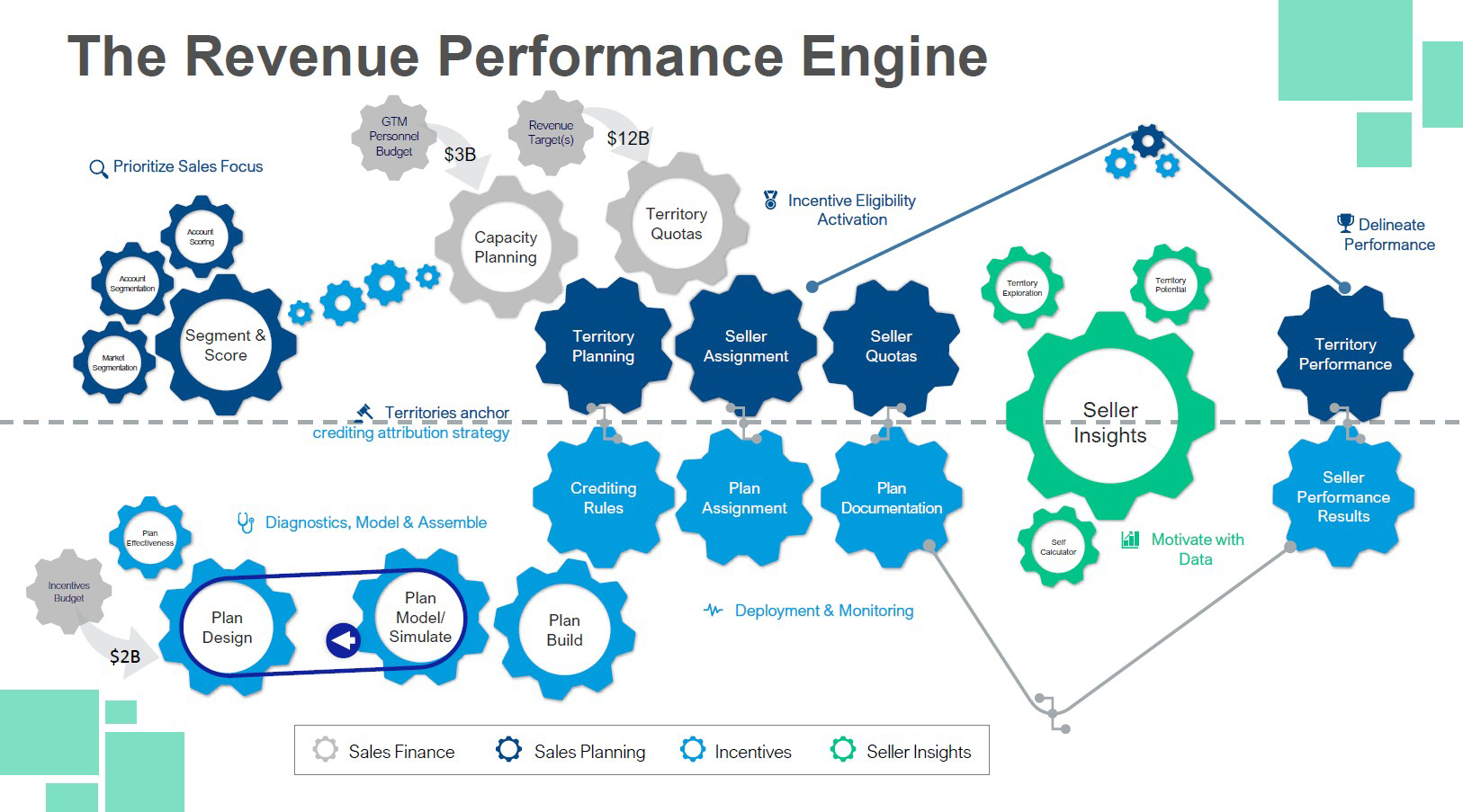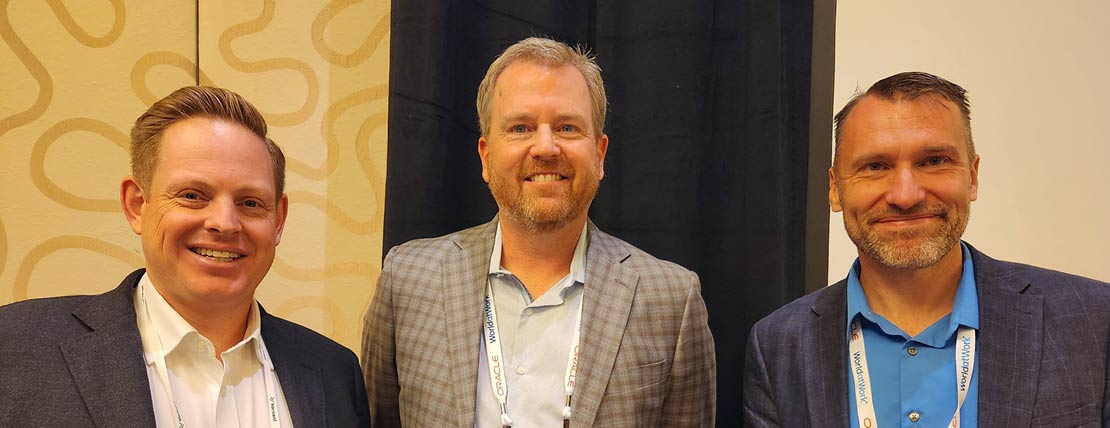- Shifting gears on sales compensation design. At PepsiCo, 20,000 sellers were moved from a commission-based pay structure to one based on bonus pay.
- CEO confidence is on the decline. According to SBI data, 52% of surveyed CEOs are confident in their growth plans, and only 59% are confident in the ability to execute growth plans.
- Consider what’s needed. Good data and analytics, plus an understanding of the customer and market, are keys to any changes to sales planning.
Sales professionals, start your revenue performance engines.
During WorldatWork’s Sales Comp’24 conference on Tuesday in San Francisco, leaders from PepsiCo and partner companies shared what gears organizations need to keep aligned and running for this total rewards vehicle to operate effectively.
Speakers for the session “PepsiCo, SBI and Varicent: Building a Revenue Performance Engine — Integrating Sales Compensation and Planning for More Sustainable Growth” included (pictured above, from left to right):
- James Mulligan, head of incentives product marketing at Varicent
- Sean Meeks, partner at Sales Benchmark Index (SBI)
- John Waldron, CSCP, total rewards and global compensation director at PepsiCo
Waldron, who has more than 25 years of sales experience, has spent the last 10 in sales compensation. In his role, he deals with 175 compensation plans and more than 100,000 sellers.
When it came to creating the right sales framework for PepsiCo, Waldron shared with the audience how he had to switch 20,000 sellers from a commission-based pay structure to one based on bonus pay. He briefly changed lanes from the session’s automotive analogy (fine-tuning and revving a Lamborghini-like sales engine) and compared the process to building a house.
“We had a bunch of rooms that we had to put all together. Then, we expected it to be a functional and livable house that’s just going to work, but what you end up with is a very awkward layout,” Waldron said. “You need an architectural layout. You need to think about the function and the purpose. You must have that holistic view of the intention of that house and how it’s all going to come together from the beginning. You don’t start all the other elements prior to that.”
A well-built car, like a well-built house, indeed comes down to design and engineering. (An example of an engine framework with its gears, provided by Varicent’s Mulligan, is pictured below.)

Mulligan also suggested sales leaders review the different gears in their performance revenue engines. “There will be easy and hard transaction points. ... One change will have a ripple effect throughout the organization,” he said.
Addressing Risks and Challenges
Ripples, or bumps in the road, can take many forms.
According to Meeks, SBI data found only 52% of surveyed CEOs are confident in their growth plans and only 59% are confident in the ability to execute growth plans. He said this information revealed four trends:
- Slowing demand elevating concerns over growth plans,
- Declining confidence in the go-to-market model but limited investment to improve,
- Lack of good data and analytics to build better strategies, and
- Investing in market penetration but seeing limited returns.
SBI data also found a 68% increase in marketing and sales expenses from 2020 to 2023. “We need a better bridge,” Meeks said, referring to sales planning. “Yes, more spending will trigger growth, but we also want good profits.”
For organizations to drive to the other side of the bridge, Meeks said sellers should reduce the amount of time they spend chasing after deals that aren’t great for the company. He also has seen more of a focus on existing customers to generate more business through new offerings and upsells.
Meeks added that data enrichment has come a long way, and when sales leaders are thinking about building good territories and territory management, using that data will help target customers and improve efficiency and productivity.
“A personalization approach is a more engaging experience, and it will lead to higher conversion rates and customer loyalty,” he said. “Statistics from CEOs show that just pulling coverage (adding more salespeople) isn’t enough. There needs to be a focus on productivity numbers.”
Data Fuels PepsiCo’s Plans
During PepsiCo’s transformation from commission to bonus, Waldron shared the challenge of moving for the first time to a structure that set quotas. First, he needed good data to leverage. Then, he and his team had to understand a “very dynamic customer base.”
With territories and commission, sellers had to be more precise, but on a bonus plan, there is now more stress put on quotas, Waldron said.
“This transformation wasn’t just a sales comp transformation. We had to figure out how to mobilize 20,000 people and get them engaged — that can be immensely powerful. That was really the starting point.”
— John Waldron, PepsiCo
“It was a new [gear] we had to build,” he said. “We ran a lot of different pilots to prove its value before we assigned this to a seller. ... We’re not a Lamborghini yet, but we were able to build a lot of things on top of a 40-year-old mainframe system.”
Waldron also had to rethink roles and their designs during this transformation. “Sometimes as a sales comp practitioner, I struggle to get clarity for some of the roles we’re trying to design,” he said. “This transformation wasn’t just a sales comp transformation. We had to figure out how to mobilize 20,000 people and get them engaged — that can be immensely powerful. That was really the starting point.”
Overall, the transformation to a bonus plan took 15 years, and it’s still an ongoing process — one that drives results for this food and beverage giant.
“We’re getting feedback on our quotas and getting good intelligence and input to where we’re learning more about the marketplace, learning more about the customers and consumers. ... All of that is critical to build our end-to-end process,” Waldron said. “It has been one of our most successful go-to-market transformations that PepsiCo has had in the last 30 years.”
Editor’s Note: Additional Content
For more information and resources related to this article, see the pages below, which offer quick access to all WorldatWork content on these topics:







